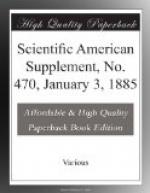and the abutment disks, B, and gear. The piston
disks and gear are attached to the driving shaft,
H, and the abutment disks and gear are attached to
the shaft, K. These shafts, H and K, as above stated,
run in taper phosphor-bronze bearings, which are adjustable
for wear or other causes by the screw-caps, O. The
whole mechanism is kept rigidly in place by the flanged
hub, r, bolted securely to the cylinder head, F. These
flanged heads project through the cylinder head, touching
the piston disk, and thereby prevent any end motion
of the shaft, H, or its attachments. The abutment
disks and shaft are furnished with similar inwardly
projecting flanged hubs, which are provided with a
recess, I, Fig. 2, on their periphery, located radially
between the shaft, K, and the clearance space, J.
Into this recess steam is admitted—through
an inlet in the cylinder head not shown in the cuts.
By this means the shaft, K, is relieved of all side
pressure. The exhaust-port, which is very large
and relieves all back pressure, is shown at D. The
pistons and disks are made to balance at the speed
at which the engine is intended to run. The steam-valve,
for which patent is pending, is new in principle.
It has a uniform rotating motion, and, like the engine,
is steam and mechanically balanced. The governor
is located in the flywheel, and actuates the automatic
cut-off, with which it is directly connected, without
the intervention of an eccentric, in such a way as
to vary the cut-off without changing the point of
admission. By this means is secured uniformity
of motion under variable loads with variable boiler
pressure. It also secures the advantage resulting
from high initial and low terminal pressure with small
clearances and absence of compression, giving a large
proportionate power and smooth action.
Expansion has been excellently provided for, the steam
passing entirely around before entering the cylinder.
These engines are mounted on a bed-plate which may
be set on any floor without especial preparation therefor.
The parts are all made interchangeable. A permanent
indicator is provided which shows the exact point
of cut-off. The steam-port is exceptionally large,
being one-fourth of the piston area. Reciprocating
motion is entirely done away with. The steam is
worked at the greatest leverage of the crank through
the entire stroke. Among the other chief advantages
claimed for this engine are direct connection to the
machinery without belts, etc., impossibility
of getting out of line, uniform crank leverage, capacity
for working equally well slow or fast, etc.
It has but one valve, which is operated by gear from
the shaft, as shown, traveling at one-half the velocity
of the piston.
[Illustration: Fig. 1.—THE HARRINGTON
ROTARY ENGINE COUPLED TO A DYNAMO.]




